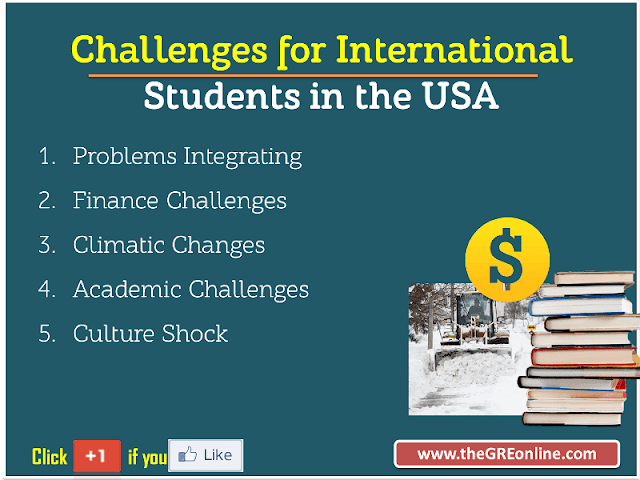Challenges for International Students in the USA
The first semester of college in the United States is an exciting time for international students, but there are some obstacles that naturally arise in a new country and academic environment.
Here are challenges international students may face, and tips to deal with each:
 |
| Challenges for International Students in the USA |
Feeling Homesick
You may feel homesick, as do many students, however for international students it is more difficult to deal with. Students from this country may be able to return home for a visit to help alleviate their homesickness. International students are not able to do this. This means that you may need more support than home students. You may need to talk to someone in confidence about how you are feeling. The counselling service is here to help.
Problems Integrating
You may find it difficult to integrate into another culture. Even within Europe cultures can be different. It may be difficult to get used to a new culture. You may wish to talk about this with other international students in a support group run by the counselling service. Please contact the counselling service for further information on support groups.
Language
You may find it difficult at first to communicate with others in university. This may be due to difficulties with language or difficulties with accents. You may find it difficult to understand your lecturer or other students. You must not be embarrassed. It is important to tell someone of your difficulties, so that you can receive help.
Finance Challenges
Studying at the university level in the United States is never a cheap venture once tuition, room and board and additional living costs are all considered. Many universities across the country offer special programs for international students, but often, this provides only a small bit of relief. Unlike American students, international students cannot benefit from U.S. federal or state-funded financial aid and must find other means of paying for school.
While studying in the U.S. can be difficult for international students, there are a several options for financial aid. There are numerous awards, grants, and scholarships that offer financial aid for international students who have performed well in school. These financial aid options are often reserved for international students who have both performed well in school prior to their U.S. studies and have been determined to really need the financial aid. When it comes to affording an education in America and seeking resources, it takes a lot of hard work and dedication, but is feasible and worth the effort! You can read more about financial aid for international students in this free guide.
Climatic Changes:
Different regions experience different climates and weather. This may prove to be a major challenge for any international student. For instance, some areas are generally cooler than others, while others are hotter. Adapting from one climatic condition to another may be quite challenging at the beginning. However, international students are advised to change their dressing style in order to adapt to the new conditions they may be facing.
Academic Challenges
International students may face several different types of academic challenges. One of the biggest differences between the U.S. educational system and that of the rest of the world is that professors in the U.S. are typically more interested in hands-on learning, classroom discussion, and group participation. This may be a tough adjustment if you are not used to this style of learning. Also, many U.S. professors make themselves easily accessible to their students. This is not always the case, but most are interested in their students and want to help with any problems that may arise. If you are having difficulty with an assignment, you should feel free to talk to a peer or professor and seek immediate help.
Remember, too, that the style of assignments may differ greatly from your home country. Whether it is working with a group to present a report or working in a science lab, the hands-on learning could take some getting used to. Most likely, the university will offer tutoring services to students who are having trouble with their studies; learning a subject in a non-native language is not the easiest feat to tackle. As an international student, don’t be afraid to take advantage of these services.
Culture Shock
Culture shock is the physical and emotional discomfort suffered when a person moves to live in another country or place that is different from their place of origin.
There are five stages to culture shock/stress
1. Honeymoon stage
2. Hostility stage
3. Adjustment
4. Home stage
5. Re-entry Shock or Reverse Culture Shock
Signs and Symptoms of Culture Shock
1. Sadness, loneliness
2. Preoccupation with health; aches and pains
3. Disturbed sleep pattern
4. Mood changes; depression, mood swings, anger, irritability.
5. Unwilling to interact with others, withdrawal
6. Loss of identity
7. Lack of confidence and reduced abilities
8. Feelings of paranoia
0 comments :
Post a Comment